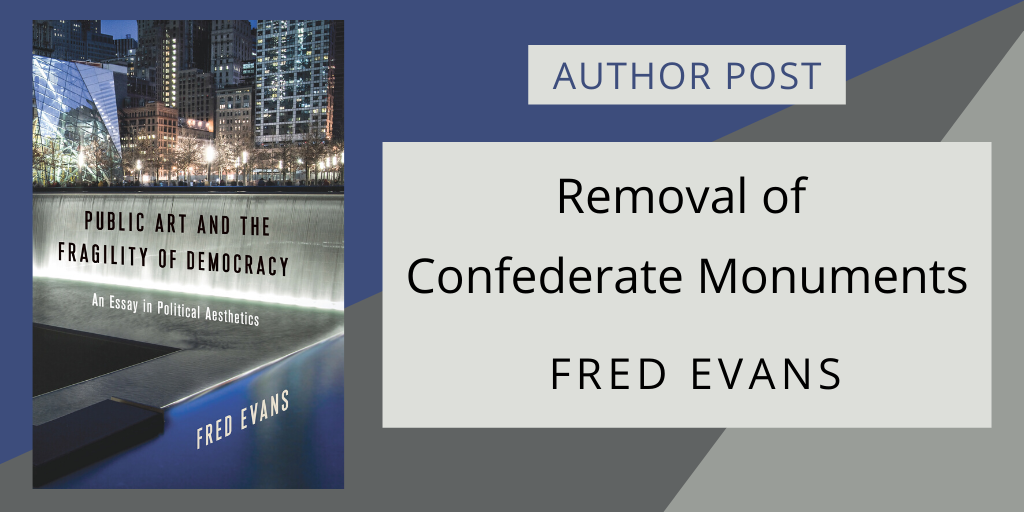The Removal of Confederate Monuments in Public Locations
By Fred Evans

“This book is a critically needed study in political aesthetics addressing complex connections between democracy, citizenship, and public art. Its systematic analysis and criticism of selected artistic projects, and ideas from such thinkers on democracy as Badiou, Derrida, Deutsche, Fraser, Lefort, Rancière, and Rawls, make this book an excellent companion to our intelligent thinking regarding the meaning and value of public art as ‘acts of citizenship.”
~Krzysztof Wodiczko, recipient of the Hiroshima Art Prize
Public space is political space. When a work of public art is put up or taken down, it is an inherently political statement, and the work’s aesthetics are inextricably entwined with its political valences. In today’s guest post, Fred Evans, author of Public Art and the Fragility of Democracy: An Essay in Political Aesthetics, considers the movement to remove Confederate statues from public spaces.
• • • • • •
When I was growing up in rural Indiana during the 1950s, my friends and I always fought over who would get to be the Confederates in our play battles. We liked the image of the “rebel.” Many years later, many lessons learned, I researched Confederate statues while writing my book Public Art and the Fragility of Democracy. The openness of the idea of democracy, its inherent questioning of its meaning, allows public art to discover new dimensions of its promise. But this same indefiniteness implies fragility: some public artworks can surreptitiously or unintentionally suggest that bigotry, authoritarianism, and unbridled commercialism are compatible with democratic values. Indeed, we’ve tolerated more than fifteen hundred Confederate monuments, all iniquitous to the Black members of our multiethnic society and to the kind of country we say we want to be.
Opponents of the removal of Confederate monuments, such as the statue of General Robert E. Lee that was removed from its location in New Orleans in 2017, have given several arguments for their position: that these monuments were a tribute only to “military valor,” that they mourned the “lost cause” of seccession, or that they were an expression of “free speech.” But the great intensity and even violence surrounding the removal of the Lee statue and, more recently, many other Confederate monuments indicate that something more contentious than reverence for gallantry, past history, or free speech is at stake.[1]
“The declaration that the annulment of slavery would never be legal or tolerated meant that those who fought under the banner of the Confederacy were fighting for an irrevocable form of racism.”
My involvement with the scholarly and popular discussions of this controversy led me to read the Constitution of the Confederate States of America. It is much like the official version, but here are at least two telling differences: the Confederate constitution invoked “the favor and guidance of Almighty God” and, more importantly here, referred to nonfree people as “slaves” and asserted that “slavery” would be a permanent institution in the Confederacy.[2] The declaration that the annulment of slavery would never be legal or tolerated meant that those who fought under the banner of the Confederacy were fighting for an irrevocable form of racism. Their constitution thereby transforms today’s claim of “valor” into brutality, “lost cause” into lost empire, and “free speech” into hate speech.[3]
A second conclusion that I reached goes beyond documentary evidence. How can we tolerate Confederate monuments and flags when they say to a number of our fellow citizens in the United States and throughout the world that they are regarded as inferior, not part of our collective body? I can’t put myself in the shoes of the Black community because I’ve never experienced racial discrimination as a daily horizon within which one must live. But I can empathize through the power of literature and first-person accounts of suffering, on the one hand, and of the dreams of a people, on the other. Sensitivity to that sorrow and that hope is enhanced by a different kind of monument, the National Museum of African American History and Culture. It is a lesson on how a democracy can redeem itself through the strength of those whom it previously marginalized.
“…there can be no moral defense for allowing Confederate monuments to remain in public locations.”
James Q. Whitman’s book Hitler’s American Model documents how the Third Reich’s Citizenship Law and Blood Law were modeled on the antimiscegenation and similar state laws promulgated especially during the Jim Crow period (late nineteenth and early twentieth centuries).[4] Indeed, Whitman reports that the Nazi legal establishment thought that some of the American racial laws were too harsh even for the German public at the time. It takes only a moment to see how offended most of us in the United States would feel if we were faced with public art that explicitly and pervasively reinforced the norms of a fascist country. But Black Lives Matter and many other voices in our society are telling us that the monuments celebrating enslavement and apartheid-like conditions have the same effect. On the basis, then, of the Confederacy’s nefarious constitution, our empathy for people whose lives and livelihoods continue to be at risk, and our desire to overturn these injustices and obtain the kind of society we would prefer to live in, there can be no moral defense for allowing Confederate monuments to remain in public locations.
[1] See Daniel Victor, “New Orleans City Council Votes to Remove Confederate Monuments,” New York Times, December 17, 2015; and Tegan Wendland, “With Lee Statue’s Removal, Another Battle of New Orleans Comes to a Close,” National Public Radio, May 20, 2017. For an example of one of these supposedly more benign reasons for not removing the memorials, see Barry D. Wood, “New Orleans Monument Removal Is a Disgrace,” Charlotte Observer, June 3, 2017.
[2] See the preamble and article I, sec. 9.4, and IV, secs 2.1, 2.3, and 3.3 of the Constitution of the Confederate States, March 11, 1861, Lillian Goldman Law Library. I take the “in perpetuity” point about slavery from J. J. McCullough; see his point by point comparison of the two constitutions, “The Constitution of the Confederate States of America”.
[3] Some say that the monuments to Washington and other slaveholding Founding Fathers should also be removed from public locations. One might argue that they drew up a constitution that, unlike the Confederate one, did not institutionalize enslavement of people and left it open to outlawing enslavement, which it eventually did. Is this too superficial to make a difference with respect to the fate of those monuments?
[4] James Q. Whitman, Hitler’s American Model: The United States and the Making of Nazi Race Law, (Princeton, NJ: Princeton University Press, 2017), 5, 127.





